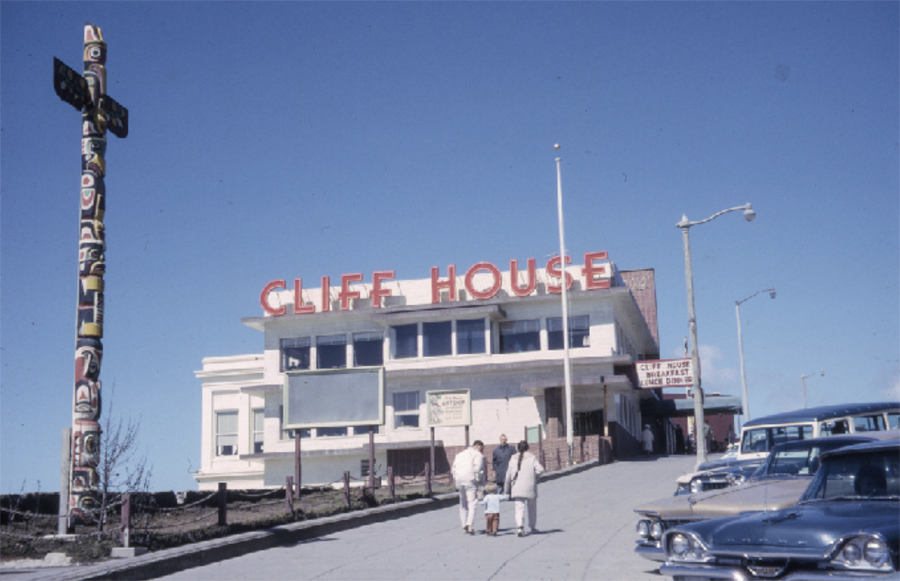By Erin Bank
Towering 58 feet above Point Lobos Avenue, just south of the building that housed the former Cliff House restaurant, a weather-beaten totem pole stands sentinel over the waves crashing onto Seal Rocks below.
The totem pole is usually not the reason people come to San Francisco’s west side, but if Nicole Meldahl, executive director of the Western Neighborhoods Project (WNP), has her way, it could serve as a beacon for the history of the area.
People have been drawn to the northern reaches of Ocean Beach for myriad reasons over time. The Cliff House building has been there, in one form or another – punctuated by multiple fires – since 1863. The Sutro Baths, still visible in ruins, opened in 1896 but was eventually demolished in 1966. The namesake of the baths, Adolph Sutro, bought the Cliff House in 1881 and lived in the cliffs above, on an estate and gardens that slowly declined until the late 1930s before becoming a park. And of course, there is the landscape itself: Point Lobos and Lands End drop into the ocean over rugged cliffs, perfect for whale watching, birding and sunset viewing.
In the 1930s and onward, many of the reasons people visited this part of the City, still bordered by dunes and dirt roads, had to do with George Whitney. In 1926, he and his brother took over management of the collection of amusement rides that would become Playland at the Beach. Whitney bought the Cliff House in 1937, and quickly built up the surrounding area. Soon, concessions including the “World’s Largest Gift Shop” and the Camera Obscura, which still stands today, were constructed.
“He made the west side a destination place,” Meldahl said.
In 1948, Whitney commissioned a totem pole from artist Chief Mathias Joe Capilano from the Squamish Nation in British Columbia. The original totem pole, which was carved to represent members of the Whitney family, was erected just north of the Cliff House. At some point in the 1950s, the totem pole was broken into two pieces, both of which were relocated to the other side of the Cliff House. The lower piece somewhat mysteriously disappeared in 2000, but the other piece remains in the same location. Its paint is faded, but the multi-colored characters extend into the sky, teeth bared and eyes bulging.
By the 1970s, however, Playland and the Sutro Baths had been demolished. The National Park Service (NPS) acquired the Cliff House in 1977 when it, and the surrounding land, became part of the Golden Gate National Recreation Area. The first concessionaire of the NPS-owned Cliff House was the Hountalas family – Greek immigrants who started out as peanut vendors. They kept many artifacts from Playland and the Sutro Baths in the building and kept the totem pole on the site. They had several auctions over the years to clear up space, and most of the items went into private collections. The last of these auctions occurred in 2021, after the NPS did not renew its contract with the Hountalas family and closed the Cliff House restaurant.
The Western Neighborhoods Project, a local nonprofit dedicated to the history of western San Francisco, was ready. It raised more than $150,000 to preserve as many items as it could, including the totem pole. The problem is, they do not own the land on which it stands.

Following the auction, the WNP used the vacant Cliff House building as a temporary museum to exhibit the pieces, then moved everything to its office on Balboa Street. Everything, that is, except the totem pole.
Although Meldahl said NPS has been sympathetic to the conundrum of moving a totem pole, they do want it gone.
“We got an eviction notice,” she said.
She has been searching for a proper home. The trouble is, San Francisco doesn’t have a single umbrella entity that is responsible for collecting, storing, and exhibiting local historical artifacts. This means many pieces sit in private collections and aren’t always accessible to the general public. Meldahl and the WNP has essentially been going door to door to ask local arts and history groups, or even local businesses along the Great Highway, if they want a totem pole.
“They all respectfully declined,” Meldahl said.
There is also the issue of the fact this is a piece of art from an Indigenous artist, albeit commissioned by a white person and from a member of a First Nation that did not call this region home. The WNP has reached out to the American Indian Cultural District to ensure any historical interpretation is done with sensitivity.
“This shouldn’t be a pain point for anyone,” Meldahl said.
Although the NPS initially said the piece didn’t have historical value, Meldahl is hopeful that a new interpretive plan can be put into place – one that can center the history of the area on the totem pole.
It is also rumored that a new tenant for the building has been selected. Meldahl’s vision is to include ways to highlight the role of indigenous peoples, the Whitney family, and the families like the Hountalases who ran concessions, in the history of the west side of San Francisco.
What can western residents do to help?
“Tell us (WNP) what you think is important,” Meldahl said. “Also, does anyone want a totem pole?”
Categories: National Park Service












Yes! I want a totem pole!
LikeLike
How about asking SFUSD if there’s a schoolyard where it could go. Or what about the Ferry Building?
LikeLike
What is going on with NPS?? Why can’t leave it! It DOES have historical value for those of us that have lived here for many years. I am so disappointed with NPS lately, especially with the way the agency has handled The Cliff House and Louis’ Diner.
LikeLike
How about Sutro Park? Is that part of GGNRA or is it a city park? Agree about NPS in this case!
LikeLike